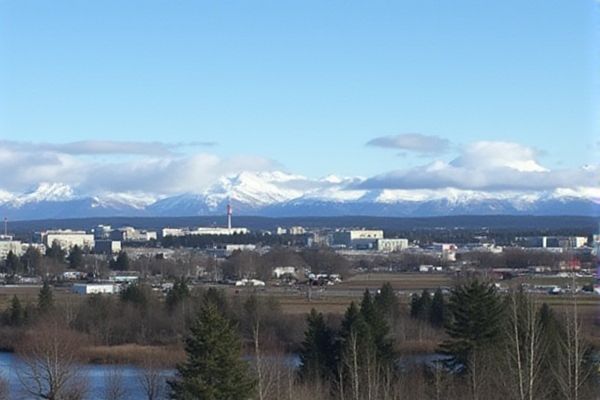
Moving to Alaska checklist: Research Alaska's harsh climate and seasons. Understand cost of living differences. Obtain appropriate cold-weather clothing. Explore transportation and vehicle requirements. Learn about local wildlife and safety precautions. Familiarize with state employment opportunities. Secure housing before arrival. Investigate healthcare facilities. Know state taxes and financial implications. Connect with community resources and social groups.
Research Alaska's harsh climate and seasons.
Alaska's climate is a unique and formidable force of nature, characterized by a range of conditions from maritime influences in the coastal regions to the severe arctic climate found in the northern reaches. It experiences notable temperature extremes, with summer highs around 59°F (15°C) and winter lows plunging to -40°F (-40°C). Additionally, precipitation levels in Alaska can be inconsistent, with some areas receiving substantial amounts. The impacts of climate change in Alaska are profound, as the state is warming at a rate two to three times greater than the global average, leading to diminished ice coverage, increased precipitation in certain regions, and more frequent extreme weather events such as heavy rains and flooding. Furthermore, Alaska distinguishes itself with four distinct seasons: a mild summer stretching from mid-May to mid-August, a harsh winter marked by subfreezing temperatures and abundant snowfall, and the transition of spring and fall, each offering unique weather patterns and activities for residents and visitors alike.
Understand cost of living differences.
The cost of living in Alaska is notably 30% higher than the national average. This encompasses various essential expenses where housing is 17% higher, utilities are a significant 49% higher, food surges by 36%, and healthcare expenses rise by 48%. Key expenses like transportation and goods & services are also considerably higher. However, Alaska's lack of personal income and state sales tax can provide some relief from these elevated costs. For a detailed analysis, the Cost of Living Calculator offers valuable insights into managing these expenses.
Obtain appropriate cold-weather clothing.
To prepare for Alaska's cold weather, it is crucial to pack essential layers including an insulated jacket, moisture-wicking base layers, fleece or wool mid-layers, and waterproof outer layers. Additionally, remember to include insulated boots, liner gloves, insulated gloves or mittens, a warm hat, thermal socks, and a neck gaiter to ensure warmth and protection against the elements. For a comprehensive list of these necessities and more tips, visit the Alaska Winter Packing List on Revel Treks and Tours.
Explore transportation and vehicle requirements.
When moving to Alaska, transportation options include driving via the Alaska Highway, taking a ferry through the Alaska Marine Highway System, or flying into major cities like Anchorage or Fairbanks. If driving, you must pass through Canada and comply with Canadian travel requirements, and once in Alaska, you need to register your vehicle within 10 days of establishing residency. For more detailed guidance on this process, consider visiting the U-Haul Moving Tips page for additional insights on relocating to Alaska.
Learn about local wildlife and safety precautions.
When moving to Alaska, it is crucial to learn about local wildlife and safety precautions, including keeping a safe distance from animals, not feeding or approaching wildlife, maintaining a clean camp, and being aware of bear behavior to avoid conflicts. Additionally, make noise while walking, travel in groups, and store food and trash properly to prevent attracting bears and other wildlife. For detailed guidelines and safety measures, visit the National Park Service website to ensure your adventures in Alaska are both exciting and safe.
Familiarize with state employment opportunities.
Familiarize yourself with state employment opportunities in Alaska through the Department of Transportation and Public Facilities, which offers roles in Civil Engineering, Highway Design, Roadway Maintenance, Marine Engineering, and Aviation, among others, with a focus on developing and maintaining the state's infrastructure. For more detailed information on available positions and application processes, visit the official Department of Transportation and Public Facilities website.
Secure housing before arrival.
To secure housing before arrival in Alaska, especially for military personnel, it is crucial to use the Housing Early Assistance Tool (HEAT) to connect with your future destination and obtain housing assistance. You must also visit the Military Housing Office (MHO) upon arrival for counseling and guidance on housing options and contracts.
Investigate healthcare facilities.
The Alaska Native Medical Center (ANMC) offers comprehensive medical services, including acute, specialty, primary, and behavioral health care, and is home to a Level II Trauma Center and a Level II Pediatric Trauma Center. Alaska's healthcare system also includes tribal, military, public, and private sectors, with the Alaska Native Tribal Health Consortium providing care through village clinics, regional hospitals, and the ANMC hospital.
Know state taxes and financial implications.
Relocating to Alaska presents significant financial advantages, notably the absence of state income tax and statewide sales tax, though some municipalities may have local sales taxes. Furthermore, a unique highlight is the Annual Permanent Fund Dividend that distributes a portion of the state's oil revenues to residents, effectively assisting them in managing the higher cost of living. For more information on these benefits and other considerations, you can explore the informative guide on the Royal Alaskan Movers website.
Connect with community resources and social groups.
Connect with community resources and social groups through Refugee Assistance & Immigration Services (RAIS), which provides case management, job readiness classes, life skills orientation, and other supportive services to help integrate into Alaskan communities. Additionally, leverage Alaska 2-1-1 to connect with various community resources, including health insurance, job assistance, and other everyday needs, ensuring a smooth transition and integration into the community.
